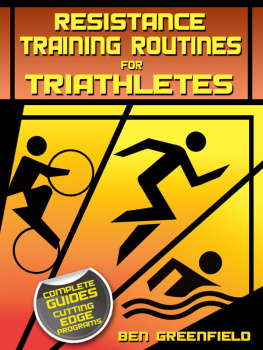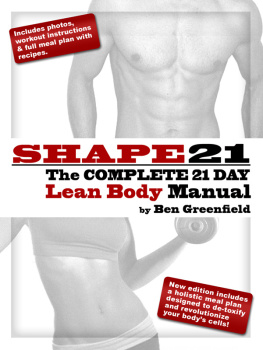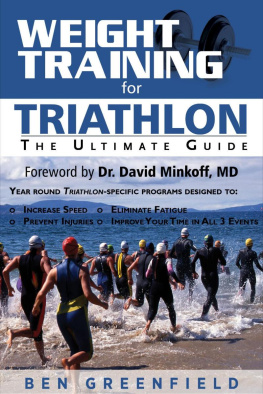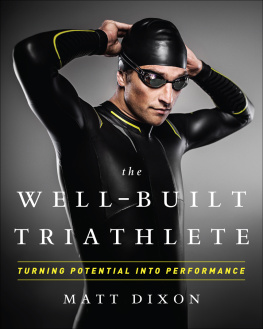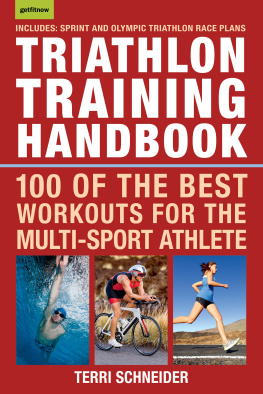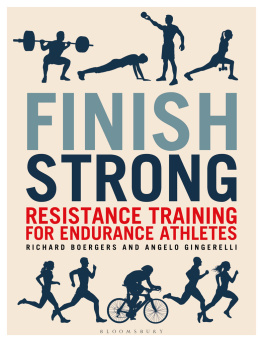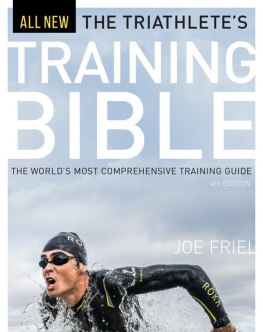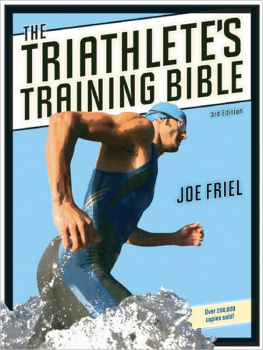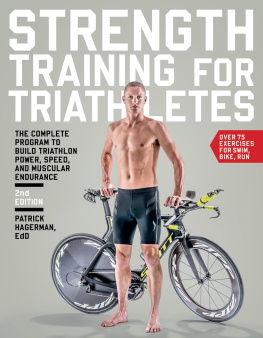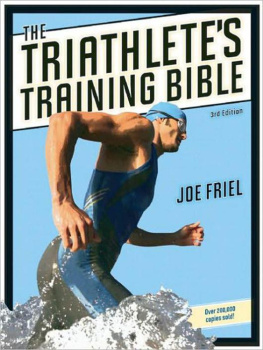Ben Greenfield - Resistance Training Routines for Triathletes
Here you can read online Ben Greenfield - Resistance Training Routines for Triathletes full text of the book (entire story) in english for free. Download pdf and epub, get meaning, cover and reviews about this ebook. year: 2012, publisher: Price World Publishing, LLC, genre: Home and family. Description of the work, (preface) as well as reviews are available. Best literature library LitArk.com created for fans of good reading and offers a wide selection of genres:
Romance novel
Science fiction
Adventure
Detective
Science
History
Home and family
Prose
Art
Politics
Computer
Non-fiction
Religion
Business
Children
Humor
Choose a favorite category and find really read worthwhile books. Enjoy immersion in the world of imagination, feel the emotions of the characters or learn something new for yourself, make an fascinating discovery.
- Book:Resistance Training Routines for Triathletes
- Author:
- Publisher:Price World Publishing, LLC
- Genre:
- Year:2012
- Rating:4 / 5
- Favourites:Add to favourites
- Your mark:
- 80
- 1
- 2
- 3
- 4
- 5
Resistance Training Routines for Triathletes: summary, description and annotation
We offer to read an annotation, description, summary or preface (depends on what the author of the book "Resistance Training Routines for Triathletes" wrote himself). If you haven't found the necessary information about the book — write in the comments, we will try to find it.
Resistance Training Routines for Triathletes is an easy to understand manual with complete instructions and guides to cutting-edge strength training programs for multi-sport athletes. This book contains the identical routines that triathlete, Ben Greenfield uses in his triathlon training, adapted for all experiences and fitness levels, and designed in an easy to follow format.
This book also includes access to detailed high-quality video instructions and workout demonstrations.
Resistance Training Routines for Triathletes — read online for free the complete book (whole text) full work
Below is the text of the book, divided by pages. System saving the place of the last page read, allows you to conveniently read the book "Resistance Training Routines for Triathletes" online for free, without having to search again every time where you left off. Put a bookmark, and you can go to the page where you finished reading at any time.
Font size:
Interval:
Bookmark:
Prior to beginning any exercise program, you must consult with your physician. You must also consult your physician before increasing the intensity of your training. The information in this book is intended for healthy individuals. Any application of the recommended material in this book is at the sole risk of the reader, and at the readers discretion. Responsibility of any injuries or other adverse effects resulting from the application of any of the information provided within this book is expressly disclaimed.
Price World Publishing
www.PriceWorldPublishing.com
Copyright 2012 by Ben Greenfield
All rights reserved. Neither this book, nor any parts within it may be sold or reproduced in any form without permission.
eISBN: 9781619841437
As you may already know, there are literally hundreds of strength training programs for triathletes. You can find them scattered across the web, among the pages of strength research journals, and in popular health and fitness magazines. The benefits of strength training cannot be denied - reduced risk of injury, enhanced force application, higher economy, and better overall health. But unfortunately, many of the strength training programs on the market today are too involved for the average triathlete - too much time, too much complication, too many exercises. In addition, many programs include components that are a waste of time for a triathlete - bicep curls, tricep pushdowns, abdominal crunches, leg extension machines, and a host of other ineffective and potentially damaging exercises.
Over years of training hundreds of different body styles and fitness levels, I have found that simple, multi-joint, functional exercises are a fast and highly effective way for the busy, multi-sport athlete to stay fit. These simple exercises can be created into brief 20-30 minute routines that can then be altered in small ways throughout the training year to follow the model of "periodization". As I will explain in the instructions, by altering weight, sets, and reps, you can optimize your training.
In the following pages, I outline twelve of the most effective resistance training routines for triathletes - routines that I follow in my own training and prescribe to many of the athletes I coach. Often, a good strength training program is the final link in a triathlete's physical chain - providing the structural integrity for enhanced speed and training efficiency in swimming, cycling, and running.
Each exercise in this manual is linked to a specific exercise video to assist you with proper form. Simply click on the workout title to go to a video for that specific workout. To jog your memory during the workout, I recommend printing the workout, then viewing each exercise video, and taking notes. You'll only need to do this once, and it will ensure perfect form! That's all for now - time to start resistance training!
Warm-up
Prior to each routine, it will be necessary to raise the temperature of the muscles. This allows the muscle to produce optimal force. If you are on a "time crunch", you can simply perform a 500 meter row on a rowing machine, 100 jumping jacks or a 2 minute effort on the bike, treadmill, or elliptical. You'll be surprised at how warm you can get your body in a short period of time. If you have extra time, 5-10 minutes is a more effective warm-up. You may also perform these routines after a swim, bike, or run. If you do this, I highly encourage a carbohydrate-protein based snack of 150-300 calories if your preceding cardio session lasts for longer than 1 hour. It is better to perform cardio first, and resistance training afterwards, but sometimes what is "ideal" is not "practical", so do what works for you. The most important consideration is that you're able to perform the exercises without low blood sugar or fatigue, since that is the quickest way to injury and ineffective training.
Stretching
Stretching is slightly overrated, as many research studies have discovered no decreased risk of injury following a pre-exercise stretch session. Do I stretch? Absolutely. 10 minutes in the morning when I awake, and during race season, 1 yoga session per week. I do not stretch because I'm concerned about rupturing a tendon or muscle during a resistance training session. I stretch to maintain overall joint balance and as a means of stress relief and relaxation. Joint balance simply means that if your hamstrings are excessively tight, they can "pull" your pelvic bone posteriorly and give you low back pain. Or if your anterior shoulder muscles are excessively tight, they can pull your shoulders forward and cause a "slump" in the shoulders. However, you can stretch at anytime during the day, and it is not necessary to precede your resistance training session with stretching.
Weight Selection, Circuits, Rest Periods, Sets and Repetitions
A circuit simply means that you proceed from one exercise to the next with little to no rest between exercises. As soon as you feel recovered, which should take 10-30 seconds, you just move on to the next exercise. You perform as many circuits as are indicated in the workout instructions.
A superset means that you perform the first exercise listed, then the second
exercise, then you take a 30-60 second rest. Repeat for as many times as are indicated in the instructions, then move on to the next superset.
You can't use the same weight and the same number of repetitions all year long without experiencing burnout and decreased performance. Just as you periodize your swimming, cycling, and running, you should also periodize your resistance training. So here are the simple rules (outlined in the table at the end of this discussion):
Off-season: this is the time to really build strength and muscle mass by performing a high number of sets and circuits, using a low number of repetitions (the number of times you lift the actual weight or perform the actual exercise in any given circuit or set), and using a heavier amount of weight. If a range of circuits is given for a routine, say, "3-5x through", then during the off-season, you will go 5x through. You'll also use the low range of repetitions, around 8-10. Choose a weight that you consider very challenging (you should be to failure by the last rep). In my routines, I will use a moderate weight for the first 1-2 circuits, then add 5-10lbs for upper body and 10-20lbs for lower body during the last several circuits.
Base: increase the number of reps and decrease the number of sets or circuits. Decrease your weight, which will naturally occur, since you'll be performing more reps. You should have an intense burn, but not be at failure by the last rep, and should really be able to do an extra 2-3 reps if you had to. This will also help you be less sore for those long swims, rides, and runs.
Build: again increase your number of reps and decrease the weight. Some people think that this should be the most "intense" time of lifting, but I've found that this actually detracts from the intense swims, rides, and runs you should be doing at this time of year. The goal is to "maintain" the strength that you've already built during off-season and base. Follow the same recommendations as base training to choose your weight.
Peak: here's a little twist - you're going to go back to the number of reps you performed in the off-season, but with much lighter weights and far fewer sets. Very important: make certain to lift explosively and quickly, and this should be easy to do since you be using lighter weights. Basically, you're enhancing power without doing too much muscle damage during this time. There should be very little burn in the muscles at the end of the set.
Race week: can be tricky and very individualized. While it's OK to llift for up to 72 hours prior to your low priority races, try to follow these basic rules for your mid-to-high priority races. No lifting for the entire week prior to Ironman or Half-Ironman, only one lifting session on the week of an Olympic distance race (early in the week and preferably core only), and only two lifting sessions the week of a Sprint distance race (early in the week). Remember that it takes about a week for a muscle to really respond to a strength training session, so none of the training you do during a race week is going to help you during the race, it is in fact going to detract from your race performance, and the only reason you would perform it is to maintain some amount of strength if you're racing several times over the course of a season.
Next pageFont size:
Interval:
Bookmark:
Similar books «Resistance Training Routines for Triathletes»
Look at similar books to Resistance Training Routines for Triathletes. We have selected literature similar in name and meaning in the hope of providing readers with more options to find new, interesting, not yet read works.
Discussion, reviews of the book Resistance Training Routines for Triathletes and just readers' own opinions. Leave your comments, write what you think about the work, its meaning or the main characters. Specify what exactly you liked and what you didn't like, and why you think so.

